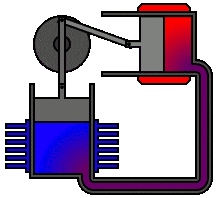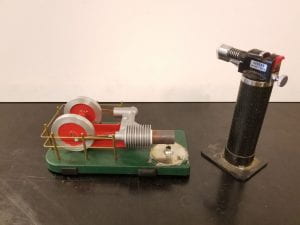Equipment:
- Stirling Engine [Cabinet D4]
- Alcohol [Fume hood]
- Lighter or Torch [Above soldering station]
Demo:
- Fill burner with alcohol and light
- Let the engine heat up
- Spin the flywheel to start
Explanation:

Figure 2: Alpha Stirling engine in action, from Wikipedia
- Cooling and compression: Most of the gas is at the cooler end of the cylinder. As it cools and contracts, giving up some of its heat, which is removed by the heat sink, both pistons move inward.
- Transfer and regeneration: The displacer piston moves and the cooled gas moves around it to the hotter part of the cylinder. The volume of the gas remains constant as it passes back through the regenerator to pick up some of the heat it previously deposited.
- Heating and expansion: Most of the gas is now on the hot end of the cylinder. It’s heated by the heat source so its pressure rises and it expands, absorbing energy. As the gas expands, it pushes the work piston to the right, which drives the flywheel and whatever the engine is powering. In this part of the cycle, the engine converts heat energy into mechanical energy.
- Transfer and cooling: The displacer piston moves again and hot gas moves around it to the cooler part of the cylinder. The volume of the gas remains constant as it passes through the regenerator, giving up some of its energy on the way. The cycle is now complete and ready to repeat itself.
